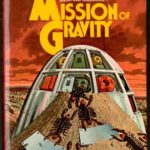These are the planets described by Harry Clement Stubbs:
- Abyormen – A planet circling a dwarf star (Theer), which in turn circles a blue giant. This produces a hot and a cold season, each of 65 years’ duration. The native intelligent life forms undergo a seasonal mass death. From Cycle of Fire.
- Dhrawn – A high-gravity world settled by Mesklinites in Star Light.
- Habranha – A planet that is tidally locked with its sun, such that the dark side is a mix of solid CO2, solid methane, and ice, and the sunlit side completely ocean, in Fossil.
- Hekla – An ice-age planet in “Cold Front” (a short story in Astounding July 1946).
- Kaihapa – An uninhabited ocean planet, twin of Kainui, in Noise.
- Kainui – An inhabited ocean planet in Noise.
- Mesklin — A planet with ultra-high gravity (up to 700 g) in Mission of Gravity. Clement later corrected his model of Mesklin and determined that the maximum surface gravity would be “only 250 gravities”.
- Sarr – An extremely hot planet with an atmosphere of gaseous sulfur, and little liquid (the natives occasionally need to drink a bit of molten copper chloride), in Iceworld
- Tenebra – A high-gravity world with a highly corrosive atmosphere consisting mostly of water vapor near its critical point, in Close to Critical.
- Enigma 88 – A small planet near η Carinae in Still River. The interior of the object is honeycombed with caves, due to evaporation of accreted ice-rich planetoids. Unusually for Clement, Enigma’s structure is not fully consistent with the laws of physics.
Details here.
–
–
videos


